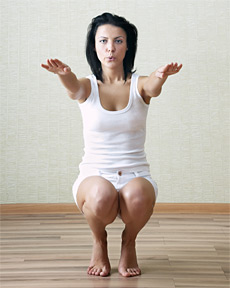Start at the Bottom: Tone and Tighten Your Glutes
By Dr. David Ryan
If you haven't noticed, millions of people are on a singular quest to develop firm, toned, well-shaped rear ends. Yes, we're talking about the bottom, the buttocks, the gluteus maximus (and minimus) - pick your favorite descriptor, depending on whom you're talking to and in what social situation. Many of us spend millions of dollars and countless more hours each year trying to achieve the ideal backside, often without success. That's because before you can shape it, you've got to understand it. You can do thousands of squats, and lunge from Tokyo to New York and back, but there's much more to it than that.
For most people, the biggest problem with toning and tightening this area of the body is lack of muscle control and getting rid of the fat layer that sits on top of the muscle. Diet and fat-burning exercise are the keys to losing unwanted inches. Getting your glutes to respond to exercise requires that you understand the muscles. The next important step is to learn to control the muscles while exercising.
 The buttocks are comprised primarily of muscles, although many would argue that their rear ends are completely loaded with just fat. This becomes a main issue for many women since the body chooses to store fat in the area of the buttocks. Eventually, your body can store so much fat in that area it would appear to look like cottage cheese (cellulite). This type of fat is very resistant to diet and exercise, but over a period of time, it is possible to remove cellulite from the body almost completely.
The buttocks are comprised primarily of muscles, although many would argue that their rear ends are completely loaded with just fat. This becomes a main issue for many women since the body chooses to store fat in the area of the buttocks. Eventually, your body can store so much fat in that area it would appear to look like cottage cheese (cellulite). This type of fat is very resistant to diet and exercise, but over a period of time, it is possible to remove cellulite from the body almost completely.
It is also very important to recognize that the body does not "spot reduce." The exercises listed in this article will tone and tighten the muscles, but you will have to lose body fat all over, including your gluteal area, to achieve your butt-tightening, backside-toning goals.
MUSCLES 101: BUTT BASICS
The main muscles of the buttocks are the gluteus maximus, medius and minimus. These are the three primary muscles, although there are other muscles in this area that are also worth considering: the deep obturators, which are buried deep under the surface; the piriformis muscle (often associated with sciatic pain); and the quadratus femoris.
It is important to learn how to control the buttock muscles - beginning right now! While you are reading this article, start squeezing your buttocks together. That's right; while you are sitting there, start flexing your butt muscles. Try to flex the right side and then the left. Do you have control yet? It's pointless to start to begin exercising until you can completely control those glutes.
Learning how to flex the gluteal muscles while you use them will enhance any exercise and result in the use of more muscle fibers. That means faster results. Recruiting more muscle fibers provides a greater response to the stimulus. For some people, this flexing is easy and natural; for others, it is a constant battle.
KEY EXERCISES TO TIGHTEN AND TONE
Camel Walks: This exercise is as old as the hills, but it works. Start with your legs stretched out together on the floor in front of you. It is important to be sitting up straight with your arms crossed (so you don't use them). Now squeeze your right buttock, then your left, so you can rock back and forth on the buttocks. As you begin to rock, slightly raise your entire right leg and inch it forward, then, as that side is moved forward, rock and squeeze the opposite side. The leg moves forward, then as you rock to the opposite side, the left leg moves. As you do this, you will have the ability to move forward or backward. As you get stronger, you may even be able to hold something (a light weight, a small child) as you're inching forward and backward.

